Hepatitis B: Analyzing the CDC Policy and its Impact
VerifiedAdded on 2022/08/17
|8
|2274
|15
Report
AI Summary
This report provides a comprehensive analysis of the CDC policy on the prevention of Hepatitis B virus (HBV) infection. It begins by outlining the policy's issues, such as the prevalence of chronic HBV and the need for effective prevention strategies, including vaccination and behavioral changes. The report then emphasizes the policy's importance in preventing a preventable disease and discusses ways to strengthen it, such as regular assessments and accessibility to all groups. The role of a nurse advocate is highlighted, emphasizing the promotion of awareness, ensuring proper treatment, and adherence to preventive measures. The report also examines the policy's impact on population health, including lowering infection and death rates, and concludes by considering the stakeholders involved in promoting the policy's cause, such as common people at risk, financial contributors, healthcare workers, and healthcare leaders. The report underscores the importance of the CDC policy in preventing the disease and ensuring patient safety.
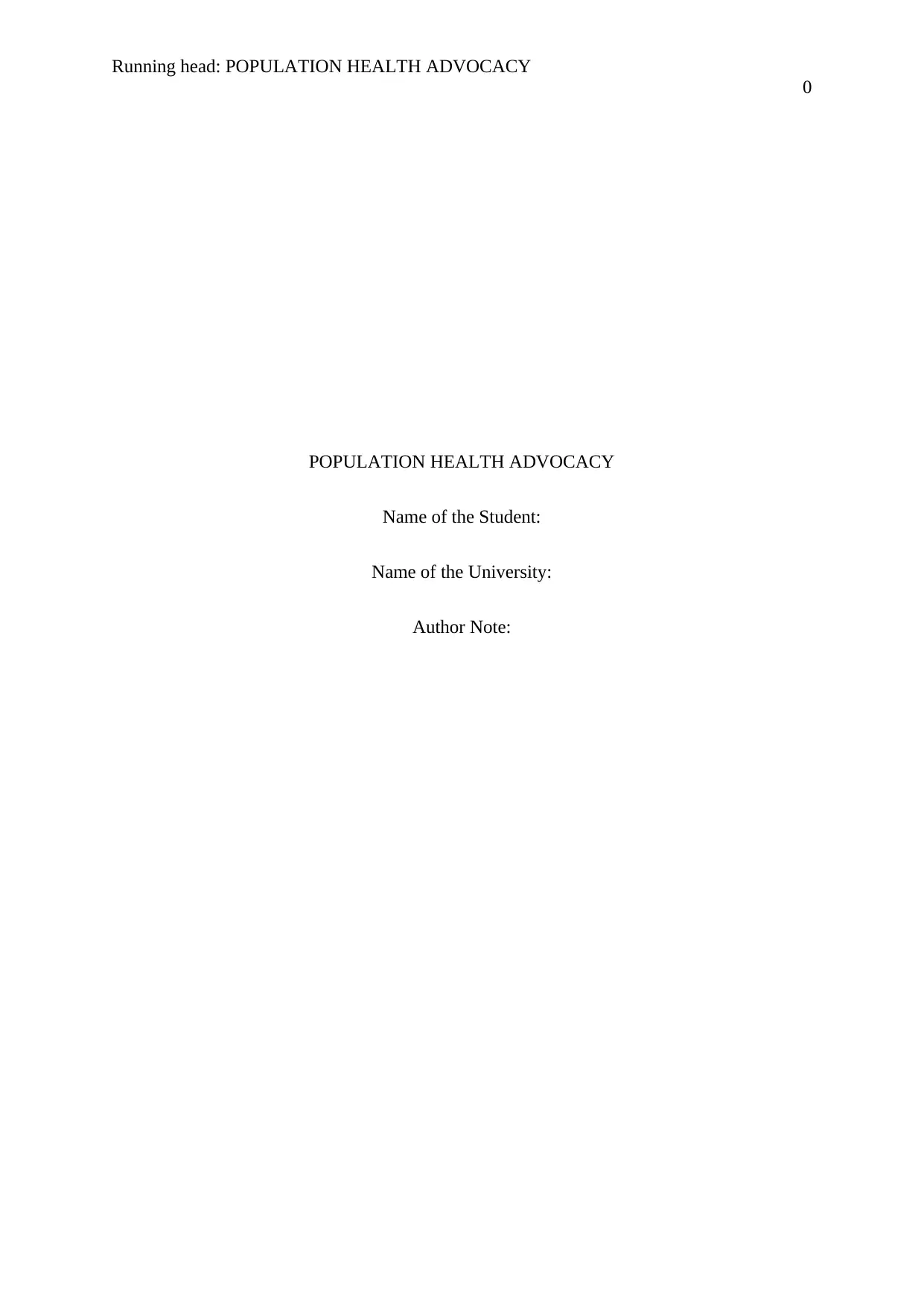
Running head: POPULATION HEALTH ADVOCACY
0
POPULATION HEALTH ADVOCACY
Name of the Student:
Name of the University:
Author Note:
0
POPULATION HEALTH ADVOCACY
Name of the Student:
Name of the University:
Author Note:
Paraphrase This Document
Need a fresh take? Get an instant paraphrase of this document with our AI Paraphraser
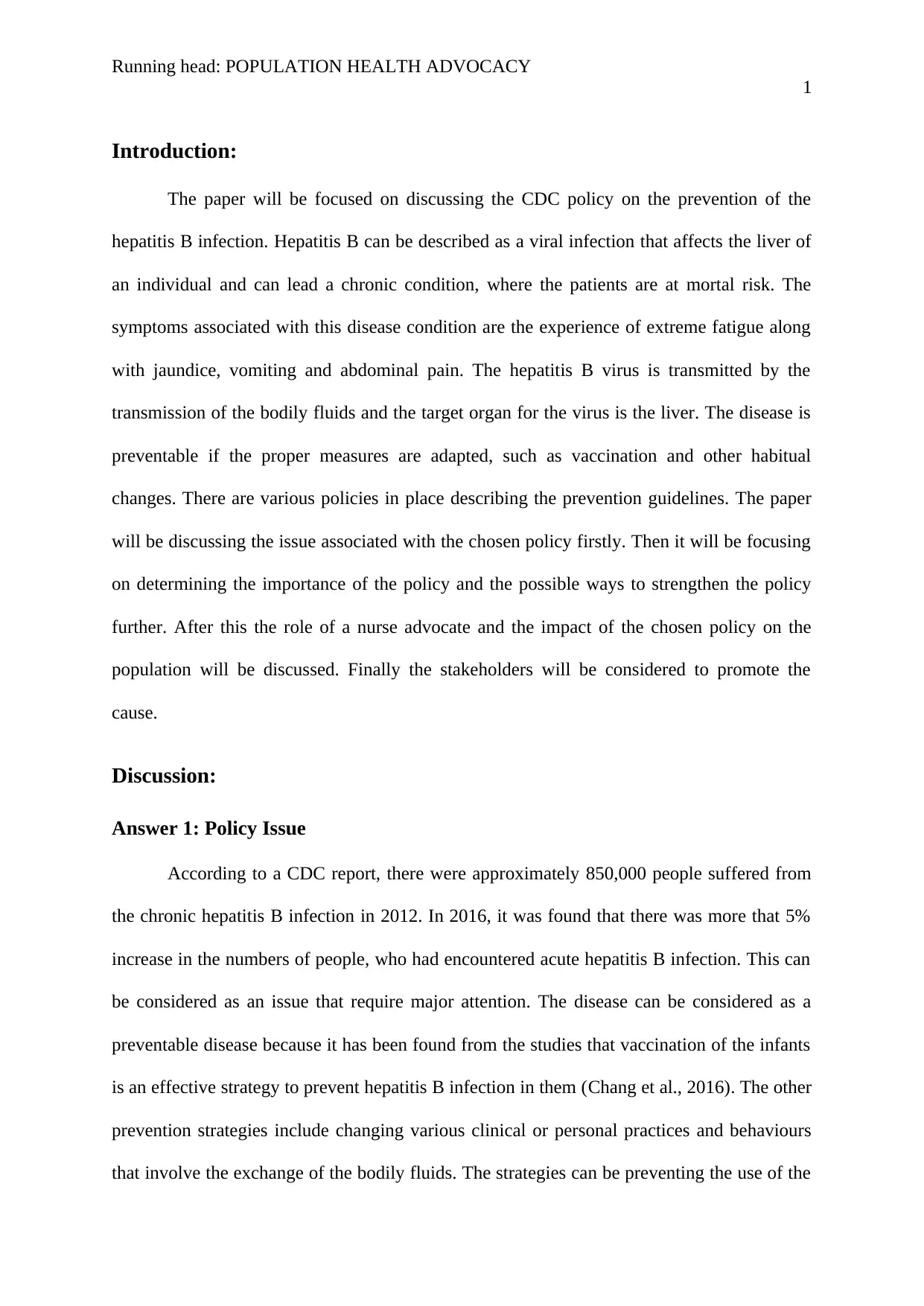
Running head: POPULATION HEALTH ADVOCACY
1
Introduction:
The paper will be focused on discussing the CDC policy on the prevention of the
hepatitis B infection. Hepatitis B can be described as a viral infection that affects the liver of
an individual and can lead a chronic condition, where the patients are at mortal risk. The
symptoms associated with this disease condition are the experience of extreme fatigue along
with jaundice, vomiting and abdominal pain. The hepatitis B virus is transmitted by the
transmission of the bodily fluids and the target organ for the virus is the liver. The disease is
preventable if the proper measures are adapted, such as vaccination and other habitual
changes. There are various policies in place describing the prevention guidelines. The paper
will be discussing the issue associated with the chosen policy firstly. Then it will be focusing
on determining the importance of the policy and the possible ways to strengthen the policy
further. After this the role of a nurse advocate and the impact of the chosen policy on the
population will be discussed. Finally the stakeholders will be considered to promote the
cause.
Discussion:
Answer 1: Policy Issue
According to a CDC report, there were approximately 850,000 people suffered from
the chronic hepatitis B infection in 2012. In 2016, it was found that there was more that 5%
increase in the numbers of people, who had encountered acute hepatitis B infection. This can
be considered as an issue that require major attention. The disease can be considered as a
preventable disease because it has been found from the studies that vaccination of the infants
is an effective strategy to prevent hepatitis B infection in them (Chang et al., 2016). The other
prevention strategies include changing various clinical or personal practices and behaviours
that involve the exchange of the bodily fluids. The strategies can be preventing the use of the
1
Introduction:
The paper will be focused on discussing the CDC policy on the prevention of the
hepatitis B infection. Hepatitis B can be described as a viral infection that affects the liver of
an individual and can lead a chronic condition, where the patients are at mortal risk. The
symptoms associated with this disease condition are the experience of extreme fatigue along
with jaundice, vomiting and abdominal pain. The hepatitis B virus is transmitted by the
transmission of the bodily fluids and the target organ for the virus is the liver. The disease is
preventable if the proper measures are adapted, such as vaccination and other habitual
changes. There are various policies in place describing the prevention guidelines. The paper
will be discussing the issue associated with the chosen policy firstly. Then it will be focusing
on determining the importance of the policy and the possible ways to strengthen the policy
further. After this the role of a nurse advocate and the impact of the chosen policy on the
population will be discussed. Finally the stakeholders will be considered to promote the
cause.
Discussion:
Answer 1: Policy Issue
According to a CDC report, there were approximately 850,000 people suffered from
the chronic hepatitis B infection in 2012. In 2016, it was found that there was more that 5%
increase in the numbers of people, who had encountered acute hepatitis B infection. This can
be considered as an issue that require major attention. The disease can be considered as a
preventable disease because it has been found from the studies that vaccination of the infants
is an effective strategy to prevent hepatitis B infection in them (Chang et al., 2016). The other
prevention strategies include changing various clinical or personal practices and behaviours
that involve the exchange of the bodily fluids. The strategies can be preventing the use of the
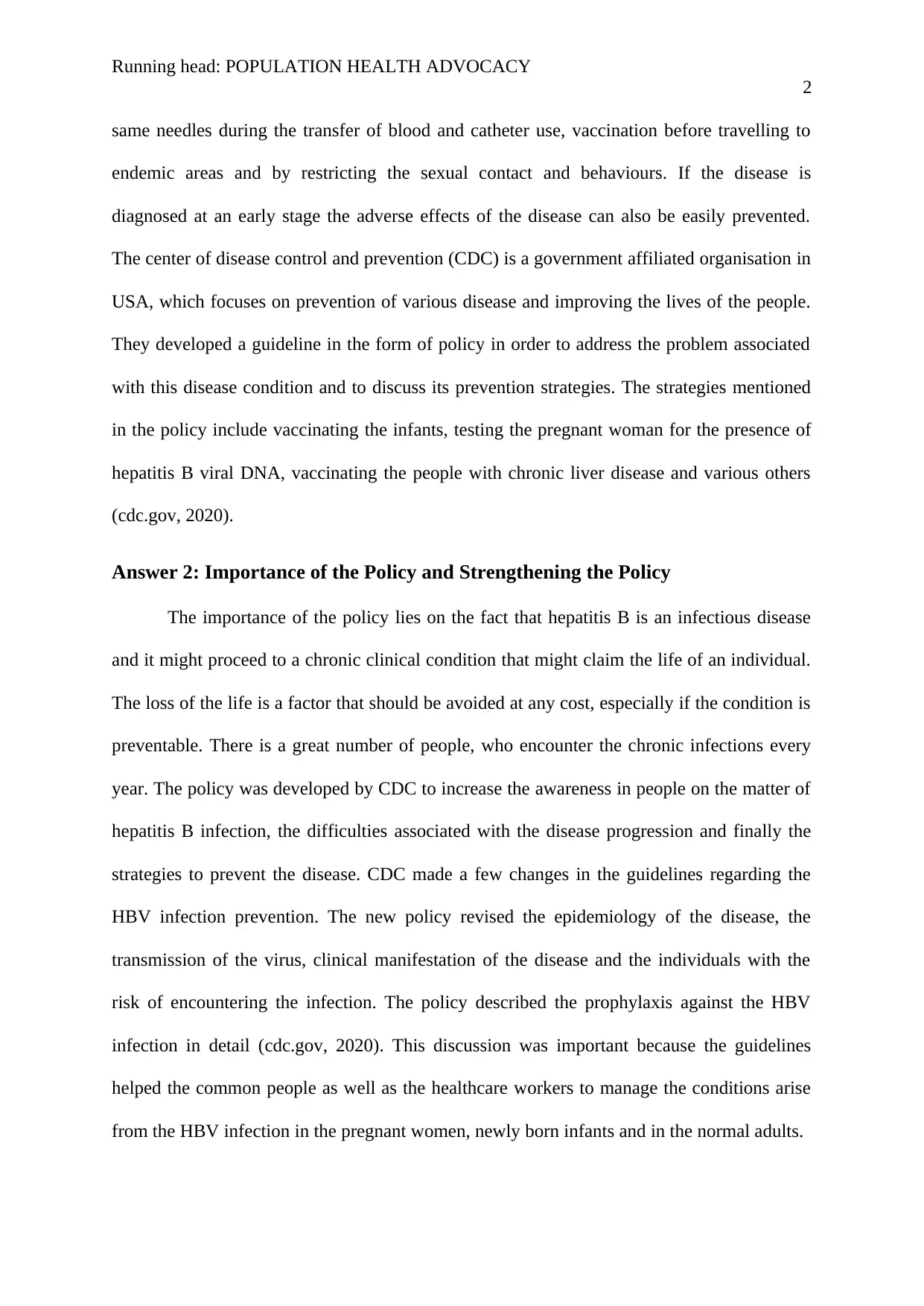
Running head: POPULATION HEALTH ADVOCACY
2
same needles during the transfer of blood and catheter use, vaccination before travelling to
endemic areas and by restricting the sexual contact and behaviours. If the disease is
diagnosed at an early stage the adverse effects of the disease can also be easily prevented.
The center of disease control and prevention (CDC) is a government affiliated organisation in
USA, which focuses on prevention of various disease and improving the lives of the people.
They developed a guideline in the form of policy in order to address the problem associated
with this disease condition and to discuss its prevention strategies. The strategies mentioned
in the policy include vaccinating the infants, testing the pregnant woman for the presence of
hepatitis B viral DNA, vaccinating the people with chronic liver disease and various others
(cdc.gov, 2020).
Answer 2: Importance of the Policy and Strengthening the Policy
The importance of the policy lies on the fact that hepatitis B is an infectious disease
and it might proceed to a chronic clinical condition that might claim the life of an individual.
The loss of the life is a factor that should be avoided at any cost, especially if the condition is
preventable. There is a great number of people, who encounter the chronic infections every
year. The policy was developed by CDC to increase the awareness in people on the matter of
hepatitis B infection, the difficulties associated with the disease progression and finally the
strategies to prevent the disease. CDC made a few changes in the guidelines regarding the
HBV infection prevention. The new policy revised the epidemiology of the disease, the
transmission of the virus, clinical manifestation of the disease and the individuals with the
risk of encountering the infection. The policy described the prophylaxis against the HBV
infection in detail (cdc.gov, 2020). This discussion was important because the guidelines
helped the common people as well as the healthcare workers to manage the conditions arise
from the HBV infection in the pregnant women, newly born infants and in the normal adults.
2
same needles during the transfer of blood and catheter use, vaccination before travelling to
endemic areas and by restricting the sexual contact and behaviours. If the disease is
diagnosed at an early stage the adverse effects of the disease can also be easily prevented.
The center of disease control and prevention (CDC) is a government affiliated organisation in
USA, which focuses on prevention of various disease and improving the lives of the people.
They developed a guideline in the form of policy in order to address the problem associated
with this disease condition and to discuss its prevention strategies. The strategies mentioned
in the policy include vaccinating the infants, testing the pregnant woman for the presence of
hepatitis B viral DNA, vaccinating the people with chronic liver disease and various others
(cdc.gov, 2020).
Answer 2: Importance of the Policy and Strengthening the Policy
The importance of the policy lies on the fact that hepatitis B is an infectious disease
and it might proceed to a chronic clinical condition that might claim the life of an individual.
The loss of the life is a factor that should be avoided at any cost, especially if the condition is
preventable. There is a great number of people, who encounter the chronic infections every
year. The policy was developed by CDC to increase the awareness in people on the matter of
hepatitis B infection, the difficulties associated with the disease progression and finally the
strategies to prevent the disease. CDC made a few changes in the guidelines regarding the
HBV infection prevention. The new policy revised the epidemiology of the disease, the
transmission of the virus, clinical manifestation of the disease and the individuals with the
risk of encountering the infection. The policy described the prophylaxis against the HBV
infection in detail (cdc.gov, 2020). This discussion was important because the guidelines
helped the common people as well as the healthcare workers to manage the conditions arise
from the HBV infection in the pregnant women, newly born infants and in the normal adults.
⊘ This is a preview!⊘
Do you want full access?
Subscribe today to unlock all pages.

Trusted by 1+ million students worldwide
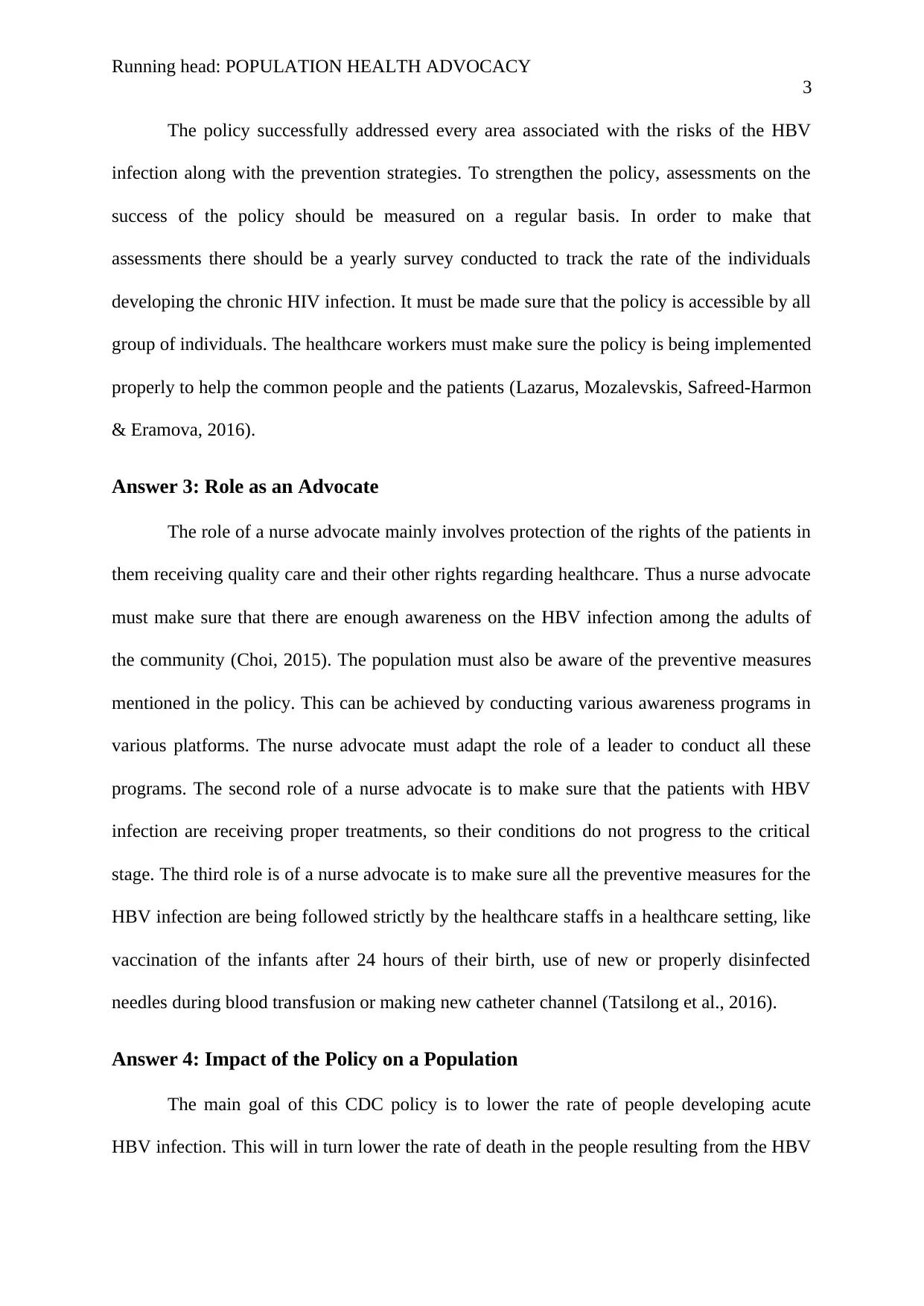
Running head: POPULATION HEALTH ADVOCACY
3
The policy successfully addressed every area associated with the risks of the HBV
infection along with the prevention strategies. To strengthen the policy, assessments on the
success of the policy should be measured on a regular basis. In order to make that
assessments there should be a yearly survey conducted to track the rate of the individuals
developing the chronic HIV infection. It must be made sure that the policy is accessible by all
group of individuals. The healthcare workers must make sure the policy is being implemented
properly to help the common people and the patients (Lazarus, Mozalevskis, Safreed-Harmon
& Eramova, 2016).
Answer 3: Role as an Advocate
The role of a nurse advocate mainly involves protection of the rights of the patients in
them receiving quality care and their other rights regarding healthcare. Thus a nurse advocate
must make sure that there are enough awareness on the HBV infection among the adults of
the community (Choi, 2015). The population must also be aware of the preventive measures
mentioned in the policy. This can be achieved by conducting various awareness programs in
various platforms. The nurse advocate must adapt the role of a leader to conduct all these
programs. The second role of a nurse advocate is to make sure that the patients with HBV
infection are receiving proper treatments, so their conditions do not progress to the critical
stage. The third role is of a nurse advocate is to make sure all the preventive measures for the
HBV infection are being followed strictly by the healthcare staffs in a healthcare setting, like
vaccination of the infants after 24 hours of their birth, use of new or properly disinfected
needles during blood transfusion or making new catheter channel (Tatsilong et al., 2016).
Answer 4: Impact of the Policy on a Population
The main goal of this CDC policy is to lower the rate of people developing acute
HBV infection. This will in turn lower the rate of death in the people resulting from the HBV
3
The policy successfully addressed every area associated with the risks of the HBV
infection along with the prevention strategies. To strengthen the policy, assessments on the
success of the policy should be measured on a regular basis. In order to make that
assessments there should be a yearly survey conducted to track the rate of the individuals
developing the chronic HIV infection. It must be made sure that the policy is accessible by all
group of individuals. The healthcare workers must make sure the policy is being implemented
properly to help the common people and the patients (Lazarus, Mozalevskis, Safreed-Harmon
& Eramova, 2016).
Answer 3: Role as an Advocate
The role of a nurse advocate mainly involves protection of the rights of the patients in
them receiving quality care and their other rights regarding healthcare. Thus a nurse advocate
must make sure that there are enough awareness on the HBV infection among the adults of
the community (Choi, 2015). The population must also be aware of the preventive measures
mentioned in the policy. This can be achieved by conducting various awareness programs in
various platforms. The nurse advocate must adapt the role of a leader to conduct all these
programs. The second role of a nurse advocate is to make sure that the patients with HBV
infection are receiving proper treatments, so their conditions do not progress to the critical
stage. The third role is of a nurse advocate is to make sure all the preventive measures for the
HBV infection are being followed strictly by the healthcare staffs in a healthcare setting, like
vaccination of the infants after 24 hours of their birth, use of new or properly disinfected
needles during blood transfusion or making new catheter channel (Tatsilong et al., 2016).
Answer 4: Impact of the Policy on a Population
The main goal of this CDC policy is to lower the rate of people developing acute
HBV infection. This will in turn lower the rate of death in the people resulting from the HBV
Paraphrase This Document
Need a fresh take? Get an instant paraphrase of this document with our AI Paraphraser
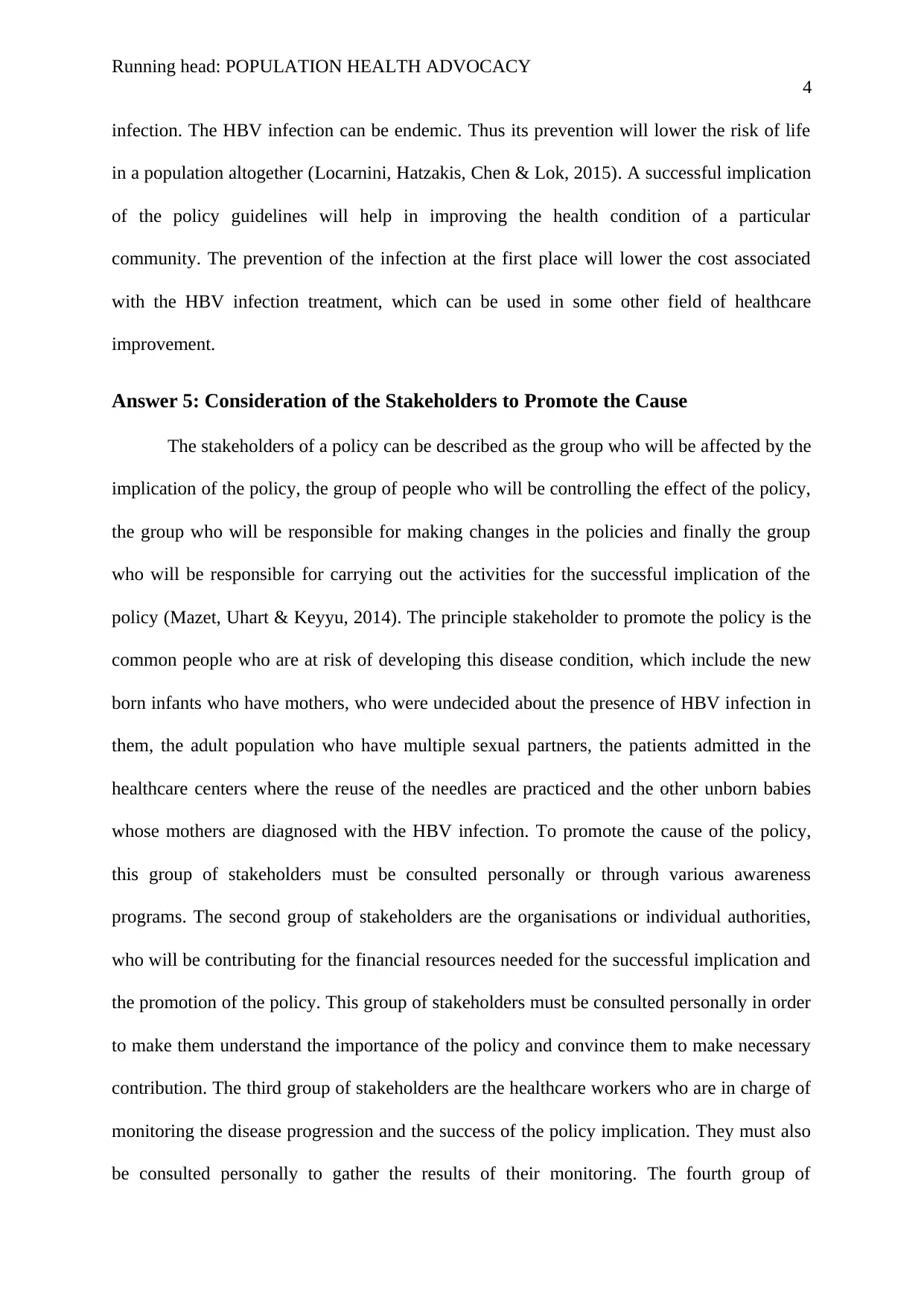
Running head: POPULATION HEALTH ADVOCACY
4
infection. The HBV infection can be endemic. Thus its prevention will lower the risk of life
in a population altogether (Locarnini, Hatzakis, Chen & Lok, 2015). A successful implication
of the policy guidelines will help in improving the health condition of a particular
community. The prevention of the infection at the first place will lower the cost associated
with the HBV infection treatment, which can be used in some other field of healthcare
improvement.
Answer 5: Consideration of the Stakeholders to Promote the Cause
The stakeholders of a policy can be described as the group who will be affected by the
implication of the policy, the group of people who will be controlling the effect of the policy,
the group who will be responsible for making changes in the policies and finally the group
who will be responsible for carrying out the activities for the successful implication of the
policy (Mazet, Uhart & Keyyu, 2014). The principle stakeholder to promote the policy is the
common people who are at risk of developing this disease condition, which include the new
born infants who have mothers, who were undecided about the presence of HBV infection in
them, the adult population who have multiple sexual partners, the patients admitted in the
healthcare centers where the reuse of the needles are practiced and the other unborn babies
whose mothers are diagnosed with the HBV infection. To promote the cause of the policy,
this group of stakeholders must be consulted personally or through various awareness
programs. The second group of stakeholders are the organisations or individual authorities,
who will be contributing for the financial resources needed for the successful implication and
the promotion of the policy. This group of stakeholders must be consulted personally in order
to make them understand the importance of the policy and convince them to make necessary
contribution. The third group of stakeholders are the healthcare workers who are in charge of
monitoring the disease progression and the success of the policy implication. They must also
be consulted personally to gather the results of their monitoring. The fourth group of
4
infection. The HBV infection can be endemic. Thus its prevention will lower the risk of life
in a population altogether (Locarnini, Hatzakis, Chen & Lok, 2015). A successful implication
of the policy guidelines will help in improving the health condition of a particular
community. The prevention of the infection at the first place will lower the cost associated
with the HBV infection treatment, which can be used in some other field of healthcare
improvement.
Answer 5: Consideration of the Stakeholders to Promote the Cause
The stakeholders of a policy can be described as the group who will be affected by the
implication of the policy, the group of people who will be controlling the effect of the policy,
the group who will be responsible for making changes in the policies and finally the group
who will be responsible for carrying out the activities for the successful implication of the
policy (Mazet, Uhart & Keyyu, 2014). The principle stakeholder to promote the policy is the
common people who are at risk of developing this disease condition, which include the new
born infants who have mothers, who were undecided about the presence of HBV infection in
them, the adult population who have multiple sexual partners, the patients admitted in the
healthcare centers where the reuse of the needles are practiced and the other unborn babies
whose mothers are diagnosed with the HBV infection. To promote the cause of the policy,
this group of stakeholders must be consulted personally or through various awareness
programs. The second group of stakeholders are the organisations or individual authorities,
who will be contributing for the financial resources needed for the successful implication and
the promotion of the policy. This group of stakeholders must be consulted personally in order
to make them understand the importance of the policy and convince them to make necessary
contribution. The third group of stakeholders are the healthcare workers who are in charge of
monitoring the disease progression and the success of the policy implication. They must also
be consulted personally to gather the results of their monitoring. The fourth group of
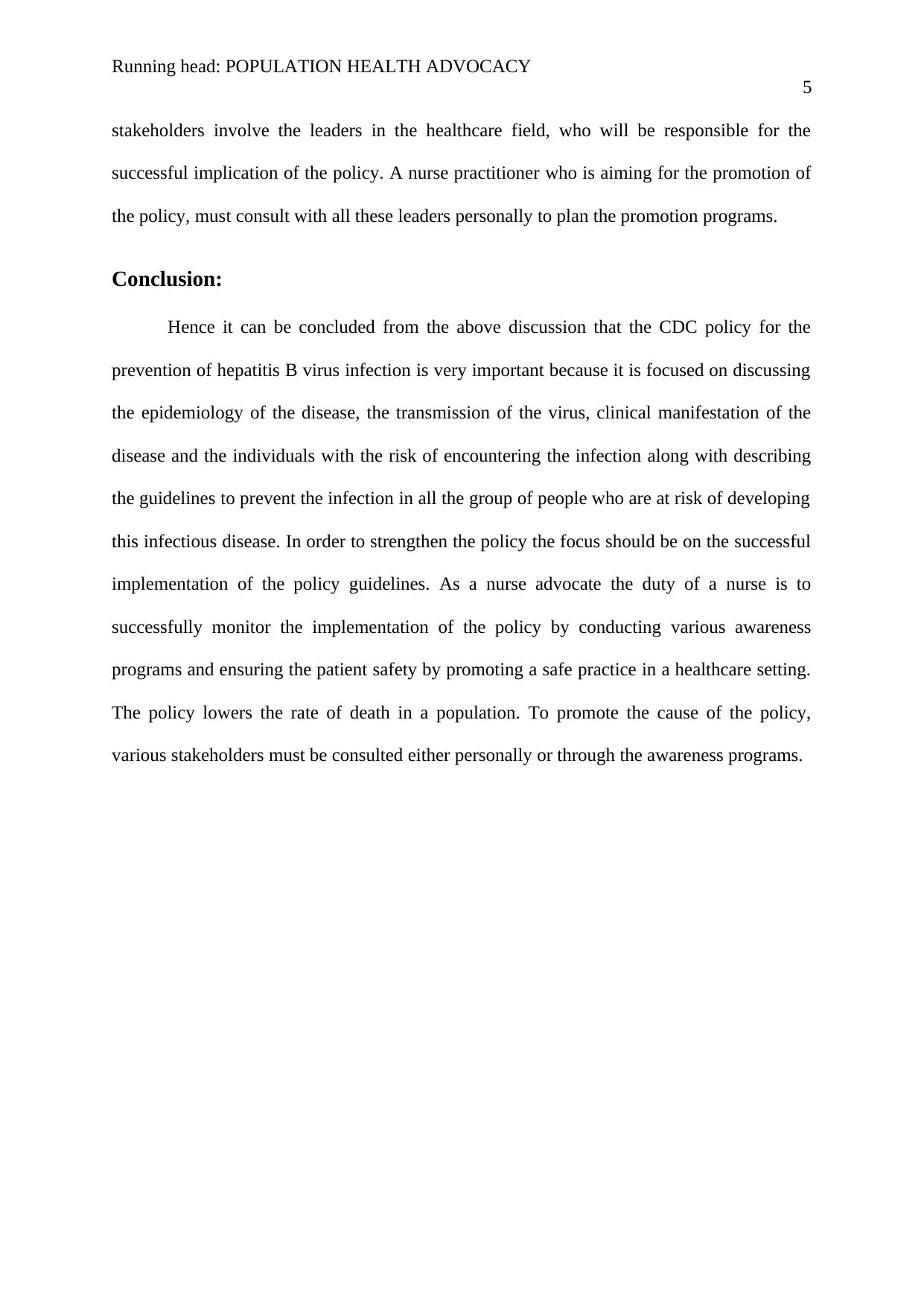
Running head: POPULATION HEALTH ADVOCACY
5
stakeholders involve the leaders in the healthcare field, who will be responsible for the
successful implication of the policy. A nurse practitioner who is aiming for the promotion of
the policy, must consult with all these leaders personally to plan the promotion programs.
Conclusion:
Hence it can be concluded from the above discussion that the CDC policy for the
prevention of hepatitis B virus infection is very important because it is focused on discussing
the epidemiology of the disease, the transmission of the virus, clinical manifestation of the
disease and the individuals with the risk of encountering the infection along with describing
the guidelines to prevent the infection in all the group of people who are at risk of developing
this infectious disease. In order to strengthen the policy the focus should be on the successful
implementation of the policy guidelines. As a nurse advocate the duty of a nurse is to
successfully monitor the implementation of the policy by conducting various awareness
programs and ensuring the patient safety by promoting a safe practice in a healthcare setting.
The policy lowers the rate of death in a population. To promote the cause of the policy,
various stakeholders must be consulted either personally or through the awareness programs.
5
stakeholders involve the leaders in the healthcare field, who will be responsible for the
successful implication of the policy. A nurse practitioner who is aiming for the promotion of
the policy, must consult with all these leaders personally to plan the promotion programs.
Conclusion:
Hence it can be concluded from the above discussion that the CDC policy for the
prevention of hepatitis B virus infection is very important because it is focused on discussing
the epidemiology of the disease, the transmission of the virus, clinical manifestation of the
disease and the individuals with the risk of encountering the infection along with describing
the guidelines to prevent the infection in all the group of people who are at risk of developing
this infectious disease. In order to strengthen the policy the focus should be on the successful
implementation of the policy guidelines. As a nurse advocate the duty of a nurse is to
successfully monitor the implementation of the policy by conducting various awareness
programs and ensuring the patient safety by promoting a safe practice in a healthcare setting.
The policy lowers the rate of death in a population. To promote the cause of the policy,
various stakeholders must be consulted either personally or through the awareness programs.
⊘ This is a preview!⊘
Do you want full access?
Subscribe today to unlock all pages.

Trusted by 1+ million students worldwide
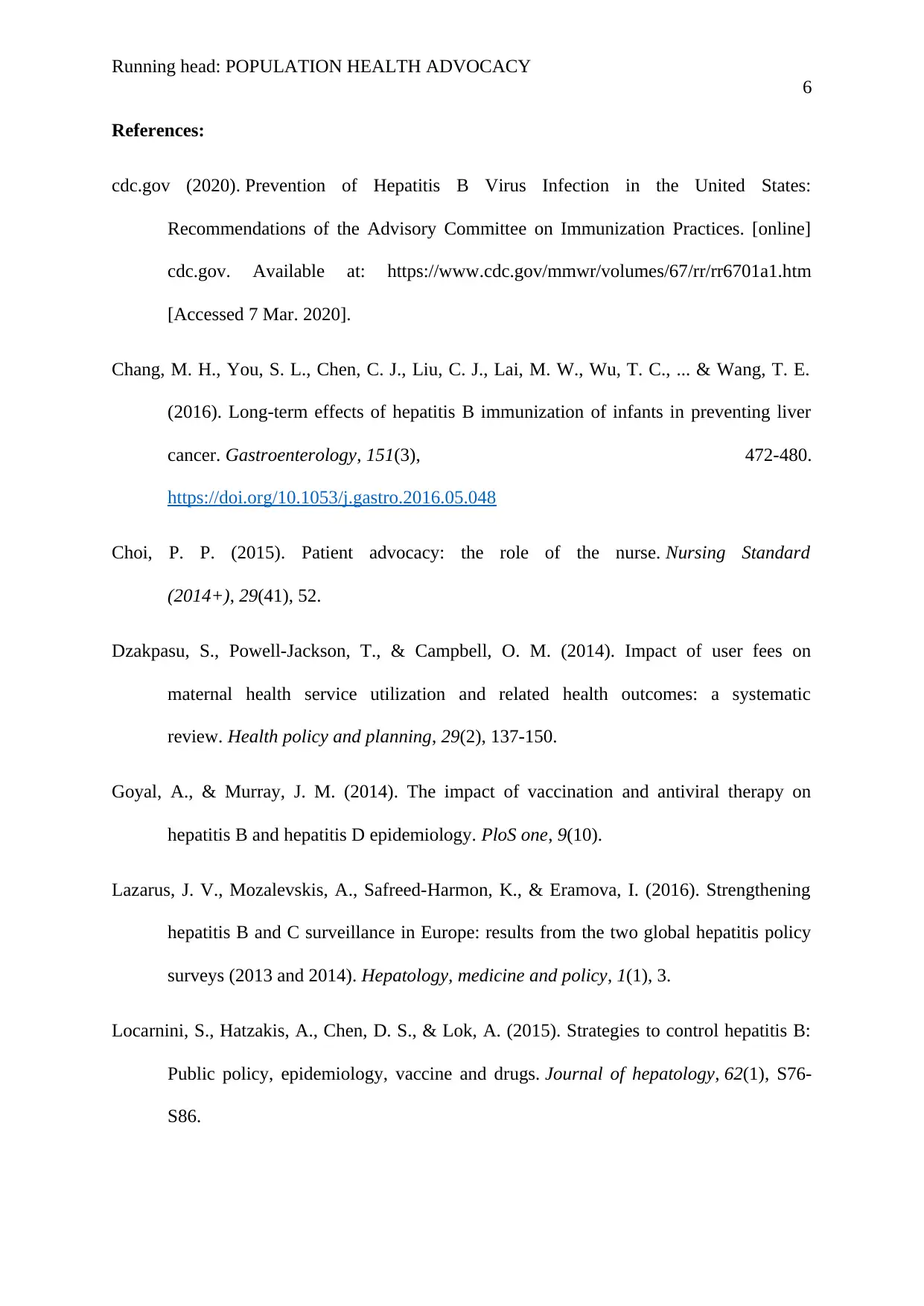
Running head: POPULATION HEALTH ADVOCACY
6
References:
cdc.gov (2020). Prevention of Hepatitis B Virus Infection in the United States:
Recommendations of the Advisory Committee on Immunization Practices. [online]
cdc.gov. Available at: https://www.cdc.gov/mmwr/volumes/67/rr/rr6701a1.htm
[Accessed 7 Mar. 2020].
Chang, M. H., You, S. L., Chen, C. J., Liu, C. J., Lai, M. W., Wu, T. C., ... & Wang, T. E.
(2016). Long-term effects of hepatitis B immunization of infants in preventing liver
cancer. Gastroenterology, 151(3), 472-480.
https://doi.org/10.1053/j.gastro.2016.05.048
Choi, P. P. (2015). Patient advocacy: the role of the nurse. Nursing Standard
(2014+), 29(41), 52.
Dzakpasu, S., Powell-Jackson, T., & Campbell, O. M. (2014). Impact of user fees on
maternal health service utilization and related health outcomes: a systematic
review. Health policy and planning, 29(2), 137-150.
Goyal, A., & Murray, J. M. (2014). The impact of vaccination and antiviral therapy on
hepatitis B and hepatitis D epidemiology. PloS one, 9(10).
Lazarus, J. V., Mozalevskis, A., Safreed-Harmon, K., & Eramova, I. (2016). Strengthening
hepatitis B and C surveillance in Europe: results from the two global hepatitis policy
surveys (2013 and 2014). Hepatology, medicine and policy, 1(1), 3.
Locarnini, S., Hatzakis, A., Chen, D. S., & Lok, A. (2015). Strategies to control hepatitis B:
Public policy, epidemiology, vaccine and drugs. Journal of hepatology, 62(1), S76-
S86.
6
References:
cdc.gov (2020). Prevention of Hepatitis B Virus Infection in the United States:
Recommendations of the Advisory Committee on Immunization Practices. [online]
cdc.gov. Available at: https://www.cdc.gov/mmwr/volumes/67/rr/rr6701a1.htm
[Accessed 7 Mar. 2020].
Chang, M. H., You, S. L., Chen, C. J., Liu, C. J., Lai, M. W., Wu, T. C., ... & Wang, T. E.
(2016). Long-term effects of hepatitis B immunization of infants in preventing liver
cancer. Gastroenterology, 151(3), 472-480.
https://doi.org/10.1053/j.gastro.2016.05.048
Choi, P. P. (2015). Patient advocacy: the role of the nurse. Nursing Standard
(2014+), 29(41), 52.
Dzakpasu, S., Powell-Jackson, T., & Campbell, O. M. (2014). Impact of user fees on
maternal health service utilization and related health outcomes: a systematic
review. Health policy and planning, 29(2), 137-150.
Goyal, A., & Murray, J. M. (2014). The impact of vaccination and antiviral therapy on
hepatitis B and hepatitis D epidemiology. PloS one, 9(10).
Lazarus, J. V., Mozalevskis, A., Safreed-Harmon, K., & Eramova, I. (2016). Strengthening
hepatitis B and C surveillance in Europe: results from the two global hepatitis policy
surveys (2013 and 2014). Hepatology, medicine and policy, 1(1), 3.
Locarnini, S., Hatzakis, A., Chen, D. S., & Lok, A. (2015). Strategies to control hepatitis B:
Public policy, epidemiology, vaccine and drugs. Journal of hepatology, 62(1), S76-
S86.
Paraphrase This Document
Need a fresh take? Get an instant paraphrase of this document with our AI Paraphraser
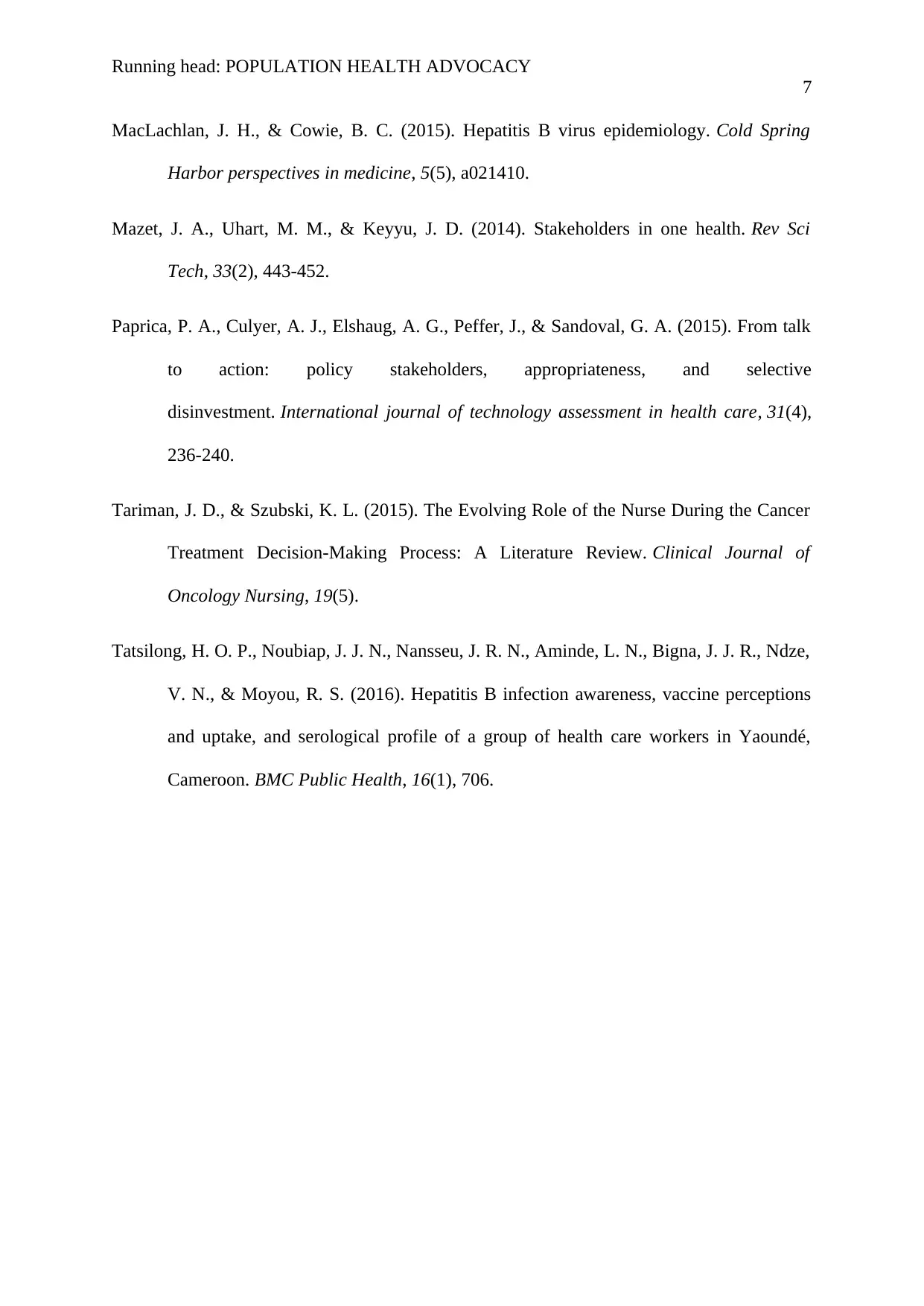
Running head: POPULATION HEALTH ADVOCACY
7
MacLachlan, J. H., & Cowie, B. C. (2015). Hepatitis B virus epidemiology. Cold Spring
Harbor perspectives in medicine, 5(5), a021410.
Mazet, J. A., Uhart, M. M., & Keyyu, J. D. (2014). Stakeholders in one health. Rev Sci
Tech, 33(2), 443-452.
Paprica, P. A., Culyer, A. J., Elshaug, A. G., Peffer, J., & Sandoval, G. A. (2015). From talk
to action: policy stakeholders, appropriateness, and selective
disinvestment. International journal of technology assessment in health care, 31(4),
236-240.
Tariman, J. D., & Szubski, K. L. (2015). The Evolving Role of the Nurse During the Cancer
Treatment Decision-Making Process: A Literature Review. Clinical Journal of
Oncology Nursing, 19(5).
Tatsilong, H. O. P., Noubiap, J. J. N., Nansseu, J. R. N., Aminde, L. N., Bigna, J. J. R., Ndze,
V. N., & Moyou, R. S. (2016). Hepatitis B infection awareness, vaccine perceptions
and uptake, and serological profile of a group of health care workers in Yaoundé,
Cameroon. BMC Public Health, 16(1), 706.
7
MacLachlan, J. H., & Cowie, B. C. (2015). Hepatitis B virus epidemiology. Cold Spring
Harbor perspectives in medicine, 5(5), a021410.
Mazet, J. A., Uhart, M. M., & Keyyu, J. D. (2014). Stakeholders in one health. Rev Sci
Tech, 33(2), 443-452.
Paprica, P. A., Culyer, A. J., Elshaug, A. G., Peffer, J., & Sandoval, G. A. (2015). From talk
to action: policy stakeholders, appropriateness, and selective
disinvestment. International journal of technology assessment in health care, 31(4),
236-240.
Tariman, J. D., & Szubski, K. L. (2015). The Evolving Role of the Nurse During the Cancer
Treatment Decision-Making Process: A Literature Review. Clinical Journal of
Oncology Nursing, 19(5).
Tatsilong, H. O. P., Noubiap, J. J. N., Nansseu, J. R. N., Aminde, L. N., Bigna, J. J. R., Ndze,
V. N., & Moyou, R. S. (2016). Hepatitis B infection awareness, vaccine perceptions
and uptake, and serological profile of a group of health care workers in Yaoundé,
Cameroon. BMC Public Health, 16(1), 706.
1 out of 8
Related Documents
Your All-in-One AI-Powered Toolkit for Academic Success.
+13062052269
info@desklib.com
Available 24*7 on WhatsApp / Email
![[object Object]](/_next/static/media/star-bottom.7253800d.svg)
Unlock your academic potential
Copyright © 2020–2025 A2Z Services. All Rights Reserved. Developed and managed by ZUCOL.





